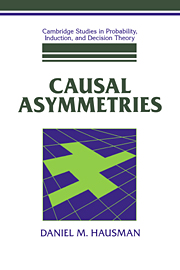Book contents
- Frontmatter
- Contents
- List of Figures
- Acknowledgments
- Introduction: Causation and its Asymmetries
- 1 Metaphysical Pictures and Wishes
- 1* Transfer Theories
- 2 Is Causation a Relation Among Events?
- 3 Causation, Regularities, and Time: Hume's Theory
- 4 Causation and Independence
- 4* Causation, Independence, and Causal Connection
- 5 Agency Theory
- 5* Causal Generalizations and Agency
- 6 The Counterfactual Theory
- 6* Independence and Counterfactual Dependence
- 7 Counterfactuals, Agency, and Independence
- 7* Agency, Counterfactuals, and Independence
- 8 Causation, Explanation, and Laws
- 8* Causation, Explanation, and Independent Alterability
- 9 Probabilistic Causation
- 10 Causation and Conditional Probabilities
- 10* Causal Graphs and Conditional Probabilistic Dependencies
- 11 Intervention, Robustness, and Probabilistic Dependence
- 11* Interventions and Conditional Probabilities
- 12 Operationalizing and Revising the Independence Theory
- 12* Probability Distributions and Causation
- 13 Complications and Conclusions
- Appendix A Alphabetical List of Propositions
- Appendix B List of Theorems
- References
- Index
Introduction: Causation and its Asymmetries
Published online by Cambridge University Press: 20 April 2010
- Frontmatter
- Contents
- List of Figures
- Acknowledgments
- Introduction: Causation and its Asymmetries
- 1 Metaphysical Pictures and Wishes
- 1* Transfer Theories
- 2 Is Causation a Relation Among Events?
- 3 Causation, Regularities, and Time: Hume's Theory
- 4 Causation and Independence
- 4* Causation, Independence, and Causal Connection
- 5 Agency Theory
- 5* Causal Generalizations and Agency
- 6 The Counterfactual Theory
- 6* Independence and Counterfactual Dependence
- 7 Counterfactuals, Agency, and Independence
- 7* Agency, Counterfactuals, and Independence
- 8 Causation, Explanation, and Laws
- 8* Causation, Explanation, and Independent Alterability
- 9 Probabilistic Causation
- 10 Causation and Conditional Probabilities
- 10* Causal Graphs and Conditional Probabilistic Dependencies
- 11 Intervention, Robustness, and Probabilistic Dependence
- 11* Interventions and Conditional Probabilities
- 12 Operationalizing and Revising the Independence Theory
- 12* Probability Distributions and Causation
- 13 Complications and Conclusions
- Appendix A Alphabetical List of Propositions
- Appendix B List of Theorems
- References
- Index
Summary
Causation apparently has several different asymmetrical features. In this book I shall say what these features are and how they are related to one another. Here is a list of many of these purported asymmetries:
Time order. Effects do not come before their causes (chapter 3).
Probabilistic Independence: Causes of a given effect are probabilistically independent of one another, while effects of a given cause are probabilistically dependent on one another (chapters 4, 12).
Agency or manipulability: Causes can be used to manipulate their effects, but effects cannot be used to manipulate their causes, and effects of a common cause cannot be used to manipulate one another (chapters 5, 7).
Counter/actual dependence: Effects counterfactually depend on their causes, while causes do not counterfactually depend on their effects and effects of a common cause do not counterfactually depend on one another (chapters 6, 7).
Over determination: Effects overdetermine their causes, while causes rarely overdetermine their effects (chapter 6).
Explanation: Causes can be cited to explain their effects, but effects cannot be cited to explain their causes and effects of a common cause cannot be cited to explain one another (chapter 8).
Invariance: If the dependent variables in an equation system are effects of the independent variables, then if one intervenes and changes the value of an independent variable and substitutes the new value in the equations, one has the best prediction of new values for the dependent variables. If on the other hand the independent variables causally depend on the dependent variables and one substitutes new values for the independent variables, then the values one calculates for the dependent variables will be incorrect (chapters 8, 11). […]
- Type
- Chapter
- Information
- Causal Asymmetries , pp. 1 - 3Publisher: Cambridge University PressPrint publication year: 1998

